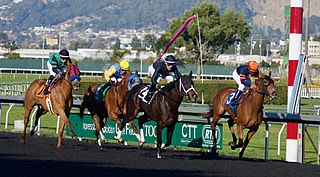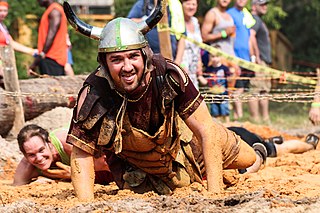
Orienteering is a group of sports that involve using a map and compass to navigate from point to point in diverse and usually unfamiliar terrain whilst moving at speed. Participants are given a topographical map, usually a specially prepared orienteering map, which they use to find control points. Originally a training exercise in land navigation for military officers, orienteering has developed many variations. Among these, the oldest and the most popular is foot orienteering. For the purposes of this article, foot orienteering serves as a point of departure for discussion of all other variations, but almost any sport that involves racing against a clock and requires navigation with a map is a type of orienteering.

Horse racing is an equestrian performance sport, typically involving two or more horses ridden by jockeys over a set distance for competition. It is one of the most ancient of all sports, as its basic premise – to identify which of two or more horses is the fastest over a set course or distance – has been mostly unchanged since at least classical antiquity.

The FIS Alpine Ski World Cup is the top international circuit of alpine skiing competitions, launched in 1966 by a group of ski racing friends and experts which included French journalist Serge Lang and the alpine ski team directors from France and the USA. It was soon backed by International Ski Federation president Marc Hodler during the FIS Alpine World Ski Championships 1966 at Portillo, Chile, and became an official FIS event in the spring of 1967 after the FIS Congress at Beirut, Lebanon.
A match race is a race between two competitors, going head-to-head.
Dirt track racing is a form of motorsport held on clay or dirt surfaced oval race tracks often used for thoroughbred horse racing. Dirt track racing started in the United States before World War I and became widespread during the 1920s and 1930s using both automobiles and motorcycles. Two different types of race cars dominate — open wheel racers in the Northeast and West and stock cars in the Midwest and South. While open wheel race cars are purpose-built racing vehicles, stock cars can be either purpose-built race cars or street vehicles that have been modified to varying degrees. There are hundreds of local and regional racetracks throughout the nation. The sport is also popular in Australia, New Zealand, Canada, South Africa and the United Kingdom.

Skijoring is a winter sport in which a person on skis is pulled by a horse, a dog, another animal, or a motor vehicle. The name is derived from the Norwegian word skikjøring, meaning "ski driving". Although skijoring is said to have originated as a mode of winter travel, it is currently primarily a competitive sport.
Rex White is a retired auto racer and NASCAR champion. White was one of the drivers who competed for the original Chevrolet racing team. He began racing in 1956, grabbing fourteen top-ten finishes. After a part-time run in 1957, White won twice in 1958. His most notable year came in 1960, when he won six races, and the NASCAR Grand National Series championship. When he retired in 1964, he had acquired 28 career victories. Throughout most of White's NASCAR career, he drove General Motors brand cars, typically painted gold and white, sporting the number "4" on the side. After he retired, White was inducted into the National Motorsports Press Association (NMPA) Hall of Fame in 1974, and was named one of NASCAR's 50 Greatest Drivers in 1998.

Sheffield has a long history of involvement in sport. Although cricket was the first organised sport, it has gradually been supplanted by football. Both the main two local football teams grew out of cricket teams. Sheffield can claim many firsts in football the most famous one being Sheffield F.C. being the world's first and oldest football club. Today it has a club in every major team sport in England. Sheffield became the first UK National City of Sport in 1995 and is now home to the English Institute of Sport (EIS).

Loveland Ski Area is a ski area in the western United States, located near the town of Georgetown, Colorado. Located at the eastern portal of the Eisenhower Tunnel, Loveland is within the Arapahoe National Forest. It is one of the closest ski areas to the Denver metropolitan area and Front Range corridor, making it popular with locals.

The Colorado Buffaloes are the athletic teams that represent the University of Colorado Boulder. The university sponsors 16 varsity sports teams. Both the men's and women's teams are called the Buffaloes or, rarely, the Golden Buffaloes. "Lady Buffs" referred to the women's teams beginning in the 1970s, but was officially dropped in 1993. The nickname was selected by the campus newspaper in a contest with a $5 prize in 1934 won by Andrew Dickson of Boulder.

Aksel Lund Svindal is a Norwegian former World Cup alpine ski racer.
Varsity Trip is the official annual ski trip organised for students of Oxford and Cambridge universities. The first event was held in Wengen, Switzerland in 1922, with British students racing against each other and the local Wengen Ski Club. The event attracted 3,200 participants in 2011, and is the largest student snowsports event in the world.
Alva Ross "AJ" Kitt IV is a former World Cup alpine ski racer from the United States. A member of the U.S. Ski Team for over a decade, Kitt specialized in the speed event of downhill, and also raced in Super-G and combined. He retired from international competition following the 1998 season with six World Cup podiums, which included one downhill victory. Kitt was a bronze medalist in the downhill at the 1993 World Championships. He also had the lead in three World Cup races which were subsequently nullified by FIS officials, due to weather conditions that did not allow the entire field of competitors to start the race. In each, Kitt was awarded the race's prize money and trophies, but not the World Cup points.

Snocross is a racing sport involving racing specialized high performance snowmobiles on natural or artificially-made tracks consisting of tight turns, banked corners, steep jumps and obstacles. Riders race at speed of up to 60 miles per hour. Jumps are up to 30 feet tall, so riders travel up to 130 feet before they touch the ground. According to the World Snowmobile Association which governs snocross, watercross, and hillcross racing, snocross is the most popular form of snowmobile racing.

Supermodifieds are a class of open wheel race car that compete on paved short tracks throughout the United States of America and Canada. The class was founded in the 1950s and is especially popular in the Western states, the Northeast and Great Lakes regions.

Obstacle course racing (OCR) is a sport in which a competitor, traveling on foot, must overcome various physical challenges in the form of obstacles. Races vary in length from courses with obstacles close together to events of several kilometers which incorporate elements of track, road and/or cross country/trail running. Courses may include climbing over walls or up ropes, monkey bars, carrying heavy objects, traversing bodies of water or mud, crawling under barbed wire, and jumping through fire.
LW12 is a para-alpine and para-Nordic sit skiing sport class defined by the International Paralympic Committee (IPC). An LW12 skier needs to meet a minimum of one of several conditions including a single below knee but above ankle amputation, monoplegia that exhibits similar to below knee amputation, legs of different length where there is at least a 7 centimetres difference, combined muscle strength in the lower extremities less than 71. For international competitions, classification is done through IPC Alpine Skiing or IPC Nordic Skiing. For sub-international competitions, classification is done by a national federation such as Alpine Canada. For para-alpine, this class is subdivided into two subclasses.: LW12.1 and LW12.2. A new sit-skier competitor with only national classification will compete as LW12.2 in international competitions until they have been internationally classified.

LW11 is a para-alpine and para-Nordic sit skiing sport class, a classification defined by the International Paralympic Committee (IPC for people with paralysis in the lower extremities and people with cerebral palsy that affects the lower half of the body. Outside of skiing, the competitor in this class is unable to walk. For international competitions, classification is done through IPC Alpine Skiing or IPC Nordic Skiing. For sub-international competitions, classification is done by a national federation such as Alpine Canada.
LW3 is a para-alpine and para-Nordic standing skiing sport class defined by the International Paralympic Committee (IPC) for skiers with a disability affecting both legs, with double below knee amputation or a combined strength total for both legs of 60, with 80 as the baseline for people without disabilities. For international skiing competitions, classification is done through IPC Alpine Skiing or IPC Nordic Skiing. The classification has two subclasses for para-alpine skiing: LW3.1 which is for people with double below the knee amputations or similar disabilities, and LW3.2 which is for people with cerebral palsy that involves moderate athetoid, moderate ataxic impairment or slight diplegic involvement.
LW9 is a para-alpine and para-Nordic standing skiing sport class, a classification defined by the International Paralympic Committee (IPC) for people with upper and lower limb function problems, and includes cerebral palsy skiers classified CP5, CP6 and CP7, along with people with hemiplegia or amputations. For international skiing competitions, classification is done through IPC Alpine Skiing or IPC Nordic Skiing. A national federation such as Alpine Canada handles classification for domestic competitions. This classification is separated into two subclasses including LW9.1 and LW9.2.